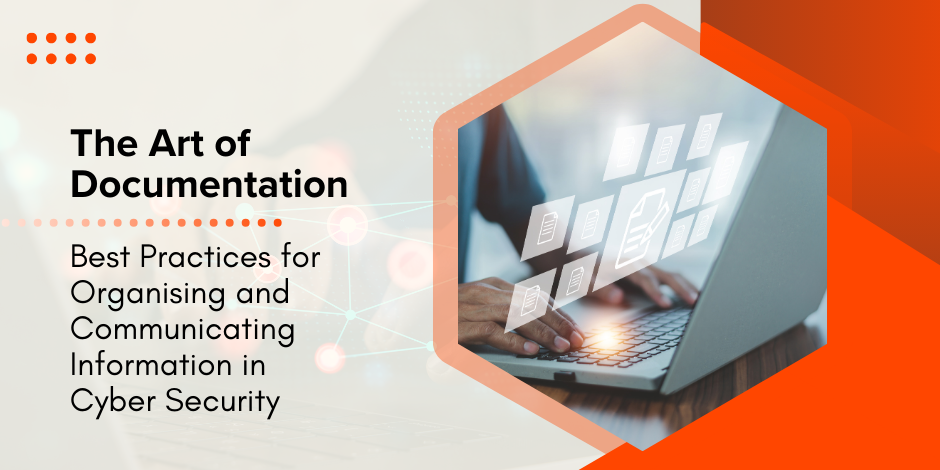The Art of Documentation: Best Practices for Organising and Communicating Information in Cyber Security

Stay Informed With Our Weekly Newsletter
Receive crucial updates on the ever-evolving landscape of technology and innovation.
Effective organisation and information communication are paramount in cyber security, where the stakes are high and the risks are always evolving.
The ability to quickly and efficiently access and understand critical security information is crucial for safeguarding against threats and making informed decisions.
Let’s dive into best practices for organising and communicating information in cyber security.
Understanding the importance of information organisation in cyber security

Organisation is the foundation upon which effective cyber security practices are built.
Without a clear and structured approach to information organisation, it becomes nearly impossible to identify and respond to security threats promptly.
In the fast-paced world of cyber security, time is of the essence.
When information is scattered and unorganised, valuable time is wasted searching for the right data to inform decision-making.
This delay can have serious consequences, as threats can spread rapidly and compromise sensitive systems and data.
The role of clear communication in cyber security
Clear and concise communication is essential in cyber security.
When security professionals cannot effectively communicate their findings, recommendations, and concerns, the chances of a breach or vulnerability going unnoticed increase exponentially.
Cyber security teams can work cohesively and efficiently by communicating information in a way that is easily digestible and understandable to all stakeholders.
Clear communication can help bridge the gap between technical experts and non-technical decision-makers, fostering a collaborative and proactive approach to security.
The impact of disorganised information on security measures
In a field where every second counts, disorganised information can spell disaster.
When crucial data is scattered across various systems, files, and platforms, the risk of oversight and missed alerts increases significantly.
Disorganisation can also lead to duplication and redundancy, as multiple sources may create and store similar information without proper coordination.
This wastes valuable resources and increases the chances of consistency and conflicting data, which can lead to confusion and ineffective decision-making.
Key principles of organising and communicating information in cyber security
Organising and communicating information in cyber security requires a structured and well-thought-out approach.
By implementing the following key principles, organisations can ensure critical security information is easily accessible and properly managed.
Developing a structured approach to data management
A structured approach to data management is essential for effective information organisation.
This involves creating a clear framework for categorising and classifying data and establishing standardised naming conventions and metadata tags.
By implementing a structured approach, organisations can easily locate and access the information they need when they need it without wasting time searching through disorganised data repositories.
Implementing effective categorisation techniques
Categorisation is a fundamental aspect of information organisation in cyber security.
Organisations can prioritise their focus and resources by categorising data based on its relevance, criticality, and associated risks.
Effective categorisation techniques include creating hierarchies, using tags and labels, and implementing automated classification systems.
These techniques facilitate easy searching and retrieval of information, reducing the time and effort required to locate critical security data.
Effective communication strategies in cyber security

Effective communication is crucial in cyber security, where collaboration and timely information sharing can make all the difference in preventing or mitigating a security incident.
The art of simplifying complex security information
One of the challenges of organising and communicating information in cyber security is dealing with highly complex and technical material.
Effectively communicating complex security information to non-technical stakeholders is a challenge all cyber security professionals face.
To bridge this gap, it is essential to simplify technical jargon and use plain language easily understood by all parties.
Visual aids like infographics and diagrams can also help convey complex concepts and relationships more effectively.
By simplifying complex security information, organisations can ensure that all stakeholders are on the same wavelength and can make informed decisions.
Promoting open and regular communication within the team
Organising and communicating information in cyber security involves high levels of collaboration.
Effective communication within the cyber security team is paramount to success.
Regular team meetings, brainstorming sessions, and knowledge-sharing platforms can help foster a culture of open communication, collaboration, and continuous improvement.
Encouraging team members to voice their concerns, share their findings, and seek feedback from their peers can increase situational awareness and a proactive approach to security.
Transparent and open communication channels can also help quickly disseminate critical alerts and updates across the organisation.
Tools and technologies to aid in information organisation and communication
Technology advancements have revolutionised cyber security, providing organisations with various tools and technologies to aid information organisation and communication.
Utilising cyber security management software
Cyber security management software, or security information and event management (SIEM) software, can help streamline information organisation and communication processes.
SIEM software collects, analyses, and correlates security events and data from various sources, providing a centralised view of the security landscape.
By integrating data from multiple systems and automating the generation of reports and alerts, SIEM software enables cyber security professionals to quickly identify and respond to security incidents.
It also provides valuable insights and trends, which can help in proactive threat detection and incident prevention.
The role of artificial intelligence (AI) in information organisation
AI has greatly impacted organising and communicating information in cyber security.
AI is a powerful tool in cyber security, offering enhanced capabilities for information organisation and analysis.
AI algorithms can process and analyse vast amounts of data, identifying patterns, anomalies, and potential threats that may go unnoticed by human analysts.
AI-powered solutions can help streamline information organisation by automatically categorising and tagging data, identifying relationships and patterns, and providing context-aware recommendations.
Additionally, AI can assist in automating routine tasks, freeing up valuable time and resources for more strategic security initiatives.
Overcoming challenges in information organisation and communication

Organising and communicating information in cyber security is not without its challenges.
By recognising and addressing these challenges, organisations can enhance their cyber security practices and improve their overall security posture.
Addressing common obstacles in data management
One common obstacle in data management is the sheer volume and variety of data generated in today’s digital landscape.
Organisations must invest in robust data storage and management solutions that can scale and accommodate the growing amount of security-related information.
Another challenge is ensuring data integrity and quality. Inaccurate or incomplete data can lead to false conclusions and inefficient decision-making.
By implementing data validation processes and ensuring data accuracy from the source, organisations can enhance the reliability of their security information.
Strategies to improve communication in cyber security teams
Poor communication within cyber security teams can hinder collaboration and impede the sharing of critical information.
Organisations can establish clear communication channels and protocols to improve communication, enabling team members to connect and exchange information easily.
Training and professional development programs can also help improve communication skills among cyber security professionals.
This includes enhancing technical and non-technical communication skills, facilitating effective knowledge transfer, and fostering a culture of continuous learning within the team.
Conclusion
Organising and communicating information in cyber security effectively is vital to a robust cyber security strategy.
By implementing the best practices for organising and communicating information in cyber security, organisations can enhance their ability to identify and respond to security threats, reduce the risk of data breaches, and maintain a proactive approach to cyber security.
From developing a structured approach to data management and implementing effective categorisation techniques to promoting open communication within the team and utilising advanced tools and technologies, organisations can build a strong foundation for successful information organisation and communication in cyber security.
By consistently prioritising and refining these practices, organisations can maximise their security posture, mitigate risks, and stay one step ahead in the ever-evolving world of cyber security.
Considering a career in cyber security?
Whether you are new to tech or a seasoned professional looking for a change, the Institute of Data’s Cyber Security Program will equip you with cutting-edge tools and technologies taught through real-world scenarios. If you would like to read about what our programs offer, download a free Cyber Security Course Outline.
Join us today for a supportive environment and a comprehensive program to get you job-ready.
Want to learn more about our programs? Our local team is ready to give you a free career consultation. Contact us today!





